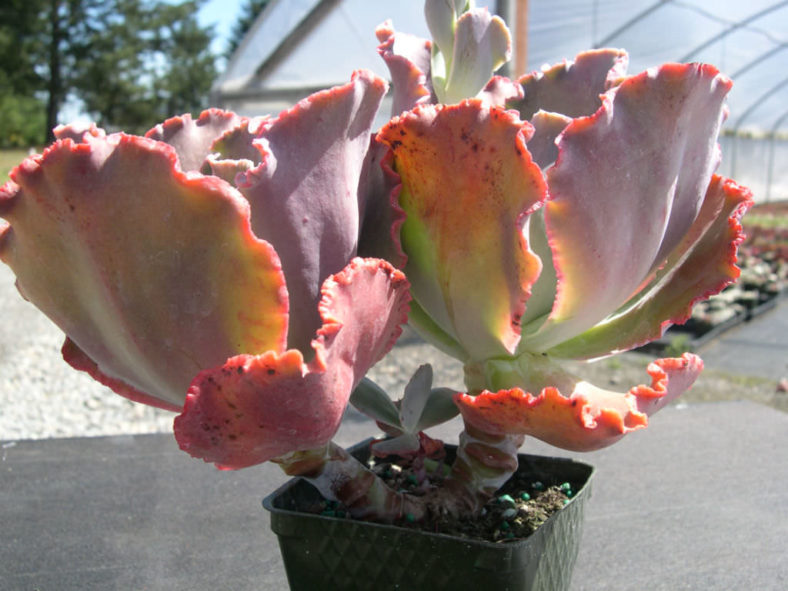Scientific Name
Echeveria 'Mauna Loa'
Synonym(s)
Echeveria gibbiflora 'Mauna Loa'
Scientific Classification
Family: Crassulaceae
Subfamily: Sempervivoideae
Tribe: Sedeae
Genus: Echeveria
Origin
Echeveria 'Mauna Loa' is a complex hybrid created by Dick Wright in 1976 with Echeveria gibbiflora 'Caronculata' and other cultivars in its parentage. It is one of the three Echeverias in his "Volcano Series", including Echeveria 'Mauna Loa', Echeveria 'Barbillion', and Echeveria 'Etna'. Similar plants are sold as Echeveria 'Red Frills' in Australia and Echeveria 'Dugong' in the Philippines.
Description
Echeveria 'Mauna Loa' is a spectacular succulent that forms large rosettes of colorful leaves that crinkle and frill at the edges. The rosettes grow on stout stems and can reach a height of 18 inches (45 cm) and a diameter of 24 inches (60 cm). The leaves are pale green when young and develop shades of blue and pink with age. The edges of the leaves can turn red to burgundy when grown in the sun.
This hybrid shows significant variations in appearance depending on the growing conditions. Some rosettes remain frilly, while others develop more carunculation.
In the fall, Echeveria 'Mauna Loa' produces orange-pink flowers that are slightly nodding and appear on tall, branched stalks.

Hybrids of Echeveria 'Mauna Loa'
How to Grow and Care for Echeveria 'Mauna Loa'
Hardiness: USDA hardiness zones 9b to 11b: from 25°F (-3.9°C) to 50°F (10°C).
Most common Echeveria species are not complicated succulents to grow, provided you follow a few basic rules. First, be careful never to let water sit in the rosette, as it can cause rot or fungal diseases that will kill the plant. Additionally, remove dead leaves from the bottom of the plant as it grows. These dead leaves provide a haven for pests, and Echeverias are susceptible to mealybugs. Finally, as with all succulents, maintaining careful watering habits and providing ample light will help ensure success.
Repot as needed, preferably during the warm season. To repot a succulent, ensure the soil is dry before repotting, then gently remove the pot. Knock away the old soil from the roots, removing any rotted or dead roots. Treat any cuts with a fungicide.
Most Echeverias can be easily propagated from leaf cuttings, although a few are better propagated from seeds or stem cuttings. To propagate a leaf cutting, place the individual leaf in potting soil for succulents and cover the dish until the new plant sprouts.
Learn more at How to Grow and Care for Echeveria.
Links
- Back to genus Echeveria
- Succupedia: Browse succulents by Scientific Name, Common Name, Genus, Family, USDA Hardiness Zone, Origin, or cacti by Genus
Photo Gallery
Click on a photo to see a larger version.


